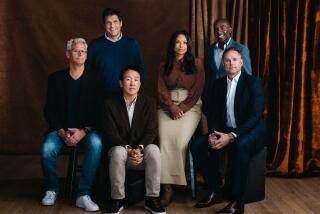Feeling the Buzz on Interactive Television
- Share via
The concept of interactive television invokes different images for different people, from selecting your own camera angles during sporting events to instantly clicking and buying the shoes Rachel is wearing on “Friends.”
Whatever form it takes, however, the one certainty in all this gee-whiz “Jetsons”-esque technology is that its operation must be no more taxing than remote control--able, as a technology executive once told me, to pass the “three-beer test,” meaning an ordinary guy can handle the requisite button-pushing after throwing back a few cold ones while watching a game.
As the cable industry’s Western Show--an annual gathering of cable TV executives and those who love them--fills the Los Angeles Convention Center this week, the question of how television viewers incorporate such advancements into their lives remains very much up in the air. So hoping to gain a glimpse of what the future holds, I recently examined what interactivity promises couch potatoes--under the influence, in one of those painful sacrifices reporters sometimes make, of three frosty beers. (For the record, I chose Sierra Nevada, a smooth, full-bodied pale ale for a clumsy, full-bodied guy.)
Perhaps the most encouraging aspect of the demonstration--a preview of sessions Liberty Livewire Corp. will be conducting for television executives at the Western Show--is that for once the techies seem to be taking the way real people watch television into account.
Specifically, Liberty, enhanced-TV pioneer ACTV and equipment marketer Universal Electronics are showcasing interactive television, including a variant that employs a two-screen approach, with a separate device--much like a Palm Pilot--that lets the viewer punch up supplementary information on the screen of a small hand-held contraption, without needing to obscure a portion of the television screen.
This trade-off had always bothered me about past exhibitions of interactivity, since the additional data was plastered all over the TV and ended up shrinking the picture down to half the screen or less--in essence turning that 32-inch TV you’re so proud of into the equivalent of a puny 14-inch model.
“That’s why we think the two-screen environment is ultimately something that is much more usable for the consumer,” said David Beddow, Liberty Livewire’s chief executive. “You don’t have to make those compromises.”
Ushered into a mock living-room setting--with furniture much nicer than my own--at Liberty’s Interactive Services Group in Hollywood, I began drinking beer as Beddow explained that the two-screen option came about because viewers had begun doing so on their own. More than 40 million people already have a computer in the same room with a television, and some watch TV while surfing the Internet.
So Universal Electronics came up with the Mosaic, a wireless, hand-held device that can operate pretty much every appliance in the house except the toaster while displaying information via a touch screen. One of the biggest advantages here is that if a couple are watching television together and one wants to find out what other movies an actor has done, he won’t annoy his companion by flashing it on the TV screen--a trait of one-screen interactivity that threatens to “increase the divorce rate in the United States,” as Universal Electronics Chairman Camille Jayne aptly noted.
The Mosaic is, indeed, pretty amazing, capable of sending and receiving e-mail as well as punching up details about the game that’s on--curious where the quarterback went to college? Press here--or the movie you’re watching.
“It won’t open your beer for you, but we’re working on it,” Jayne said.
Actually, I was doing a fine job opening beers on my own, and happily still able to manipulate both the Mosaic and a more conventional remote that conveyed statistics directly on the TV screen--sliding transparent inserts of text over the action.
Experimentation continues with various forms of interactivity. Liberty Livewire teamed with the pay channel Starz, for example, to show “The Sixth Sense” with an online computer simulcast pointing out trivia and clues--with feeds tailored to people who have seen the thriller and those who hadn’t. Viewers could also chat with one another as the movie played.
While adults might have a hard time imagining sifting through online factoids, chatting and simultaneously focusing on a movie, kids are clearly more adept at “multi-tasking” and open to the process. Moreover, programming on specialized cable channels offers untold possibilities for interactivity, from accessing recipes during cooking shows to competing during game shows to armchair-quarterbacking during sports.
Liberty doesn’t really care what form this nexus of television and the Internet takes so long as people are comfortable with it. Beddow came to his own epiphany about the two-screen variation last year, he says, based on the way viewers are independently wedding the two media. “People are doing this whether you ask them to or not,” he said. “Over time, the multiscreen environment will win out. It deals with the issue of individual personalization.”
By now I had finished the third beer, and Beddow was still making sense. As we talked, I popped up statistics on San Francisco 49ers receiver Terrell Owens after he made a catch. We then switched to a showing of “High Noon,” where I was treated to tidbits regarding the film’s underlying political message, writer Carl Foreman’s blacklisting and the fact that John Wayne--who had criticized the movie--presented Gary Cooper his best actor Oscar.
Such overlapping content could be a way to breathe life into old movies and TV shows, Beddow pointed out, at the same time giving rise to a new industry creating material to augment existing video. Granted, I knew the 1952 film marked an early bad-guy role for Lee Van Cleef, but I can see how this would interest someone who didn’t and might want to review the actor’s filmography.
Leaning back in the bogus living room, I couldn’t help but marvel at the Information Age--how a passive activity like watching television could be transformed into a two-way exchange, providing fingertip access to scads of data without ever leaving the couch.
Then it suddenly registered that I had consumed three beers, and there are still a few things even an interactive remote control can’t do for you.
*
Brian Lowry’s column appears on Wednesdays. He can be reached by e-mail at [email protected].
More to Read
The complete guide to home viewing
Get Screen Gab for everything about the TV shows and streaming movies everyone’s talking about.
You may occasionally receive promotional content from the Los Angeles Times.






